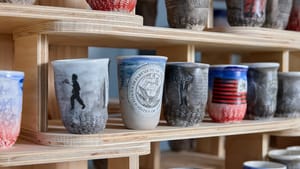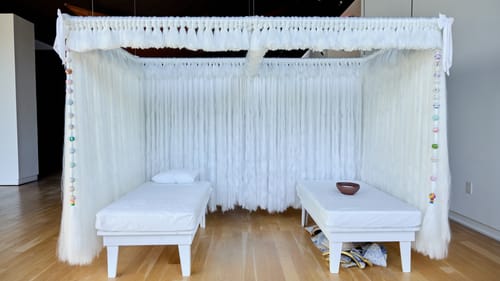Stay in the Loop
BSR publishes on a weekly schedule, with an email newsletter every Wednesday and Thursday morning. There’s no paywall, and subscribing is always free.
Clay as power, healing, and catharsis
The Clay Studio presents Clay as Care: Ceramic Art and Wellbeing

A nine-minute loop of black-and-white film depicts hands pounding a wedge of clay into a tapered dome, then dilating the top, hollowing out the vessel. The camera zooms in on slip-spackled fingers, the hypnotic counter-clockwise spin of the potter’s wheel, the gradual shaping of raw material into something practical and lovely.
In Clay as Care: Ceramic Art and Wellbeing, a spare, reflective exhibit on view at the Clay Studio through Wednesday, December 31, 2025, the process—and the interaction between maker and receiver—matters as much as the product. In the work of four very different clay artists, it’s clear that the medium can provide pathways to individual, communal, and generational healing.
Attention as a form of care
Maia Chao, who works collaboratively in social practice, film, and performance, made that short film (Roof) to explore the quality of attention and slowing of time that happens when someone is deeply immersed in artistic practice.
“I’ve been thinking a lot about … how we’re living in a time when our attention is increasingly being fractured, commodified, and split. To have a continuous channel of attention of something or someone feels like a form of care,” Chao wrote in the text describing her work.
The film shows the clay-maker’s hands working intuitively, responsively, tenderly, and firmly; we witness the slow making without ever seeing the finished, fired outcome.
And as we watch, we’re invited to relax. In lieu of the usual stiff-bench seating in galleries, viewers can lounge on a plush, stuffed twist that resembles the lovechild of a pretzel and a beanbag chair. They can sit—even lie down, if they dare—on a narrow white bed in a corner devoted to the work of Jennifer Ling Datchuk, whose work references her journey with infertility and in vitro fertilization.
Rupture and healing
In Datchuk’s installation, a visitor enters a three-sided booth with curtains of synthetic white hair, evoking a hospital cubicle or a carceral cell, to look at another twin bed and the misshapen chunks of shattered porcelain salvaged from Big Pot Factory in Jingdezhen, China, piled beneath it.
That heap summons ideas of once-beautiful, now-broken things and the semi-secret wreckage cached under so many beds. On top of that bed is a simple, shallow, oval vessel, an emptiness waiting to be filled, a counterpoint to the chaos below.

Also by Datchuk is a large color photograph of a female torso with a vertical abdominal scar—sutured, healed but never gone—and decorated with “jewelry” of small, cracked bits of porcelain. By linking the literal body with “bodies” of work, the piece reminds us that our flesh/vessel holds stories of rupture and healing, and suggests that art can make those processes both visible and recognizable.
The power of ingenuity
A third artist, Adebunmi Gbadebo, literally unearths painful portions of the past and uses them to create new work. She takes dirt from the graveyards of enslaved ancestors and mixes it with water irrigated from former plantations. She hand-builds each pot using the methods of her Nigerian ancestors and incorporates Carolina Gold rice grains and human hair in the finished vessels.
It’s a strategy she learned early in life, she explains in Watch Out for the Ghost, a film that shows her making work in South Carolina and attending family reunions. As a child, Gbadebo recalls, she responded to a school assignment by making a map of Africa with 3D flags fashioned from whatever was in the kitchen: beans, rice, toothpicks.
That ingenuity, she says in the film, is “a power we have always possessed, to transform our material reality into something sacred.”
Her work—a large terra-cotta vessel made of True Blue Plantation soil, with a ruff of stiffened human hair—haunts because the materials are literally drawn from a historical wound. And perhaps it is also a balm for that wound, reminding us, as the Chickasaw writer Linda Hogan wrote in a short story titled “Making Do, ” that we “make art out of our loss.”
A catharsis in clay
The fourth Clay as Care artist, Ehren Tool, is a Marine Corps veteran. His corner of the gallery is designed to feel like a bunker—blocks of gray clay piled up like so many sandbags, bare wooden shelves holding dozens of handle-less tumblers. Tool has made more than 26,000 cups since 2001, many of which he has given away, and calls them “a kind of catharsis in clay.”
Some cups bear a matte, pewter-colored finish; a few look singed. Others are glazed in bands of red, white, and blue, but with decidedly anti-nationalistic images and texts, etched, fired onto the clay like a photo transfer or in bas-relief. One has a design of a man in a World War I-style gas mask; another shows a raised fist in the middle of a circle-over-cross female symbol and the words, “Nevertheless, she persisted.”
There is a silhouetted figure, a target on its torso. A cup that says “Protect trans youth.” One with a quote from George Orwell; another with words from the Greek philosopher Diogenes of Sinope: “In a rich man’s house, there is no place to spit but in his face.” Recurring symbols include skulls, weapons, trees, hearts, barbed wire, and a hand making the American Sign Language gesture for I love you.
An accompanying film, an episode of “Craft in America” that first aired in November 2014, shows Tool at work and includes his “1.5-second war memorial,” a series of his cups being shot and toppled by a single bullet.
Reparation is possible
Works of clay, like the humans who create them, are both sturdy and fragile, enduring and easily broken. To make anything, these artists seem to say, is a form of care.
Visitors can try it themselves: a station invites people to make a small creation—“something that represents you as a person” or is inspired by the artists’ work—and leave it on a table to be added to an ongoing display. Viewers can also make and take a small clay worry stone.
Will any of that heal the world, or even a single spirit? Clay as Care makes a strong case that reparation is possible when we pay tender attention to the materials, the history, and the people around us.
On Saturday, October 25, there will be a Clay as Care symposium featuring artist talks, a tile-decorating activity, and keynote speaker Tricia Hersey, a theologian, community organizer, founder of The Nap Ministry, and author of Rest Is Resistance: A Manifesto.
What, When, Where
Clay as Care: Ceramic Art and Wellbeing. Through December 31, 2025, at the Clay Studio, 1425 N American Street, Philadelphia. (215) 925-3453 or theclaystudio.org.
Accessibility
The Clay Studio is a wheelchair-accessible venue.
Sign up for our newsletter
All of the week's new articles, all in one place. Sign up for the free weekly BSR newsletters, and don't miss a conversation.

 Anndee Hochman
Anndee Hochman